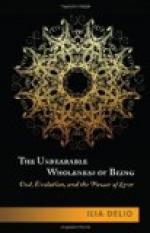The thought of the love-death, the will that the world should be governed by love, is the most unconditional postulate of feeling ever laid down. For the love-death is the definite and irrevocable victory of emotion; it is ecstasy as a solution of the world-problem and the world-process. It is human to regard love and death as antitheses; to consider them far removed from each other; marriage and funeral are the poles of social life. The ecstasy of the love-death, however, owing to its all-transcending claim, unites the two poles. The climax of life shall also be its end.
It is here, in the voluntary surrender of life in order to attain a divined unity, and not in the union of begetting and destroying, that the frequently assumed connection between love and death is to be found. Voluptuousness and death are not interlinked, as is so frequently asserted since Novalis (not on the higher plane of eroticism), but voluptuousness has immolated itself, has been annihilated in the love-death. The view that begetting and destroying are related functions, is based on the supposition that love is bound up with propagation. This is the fateful error of the modern theory of love, a rationalistic, metaphysical abstraction, which touches no corresponding chord in the human soul. To base the relationship of love and death on an association of becoming and declining is a beautiful idea, but nothing more. Modern synthetic love produces this relationship in its metaphysical perfection out of itself; it is foreign alike to pure sexuality and to spiritual love. (Wherever the desire to destroy is found hand in hand with sensuality, morbid instincts are at play.)
It frequently occurs that lovers commit suicide together because external circumstances prevent their union. This is a step corresponding to suicide from offended vanity or incurable disease; life has become unbearable to the individual haunted by a fixed idea, and he throws it away. But this has nothing whatever to do with the love-death; it is a purely negative act of despair, whereas the love-death is an altogether positive act, namely, the will to win to a higher (and to the intellect inconceivable and paradoxical) metaphysical unity. The love-death aspires to perform a miracle. It has, possibly, never been realised in its full greatness; the evidence of the common death of Heinrich von Kleist and Henrietta Vogel must be rejected. During the last days of his life Kleist was wrapped up in the idea of their common death, and in a letter to his cousin, Marie von Kleist, he says: “If you could only realise how death and love strive to beautify these last moments of my life with heavenly and earthly roses, you would be content to let me die. I swear to you I am supremely happy.” In the same letter he speaks of “the most voluptuous of deaths.” And yet it was no real love-death, that is to say, death following as a necessary corollary in order that love may be consummated. Kleist




